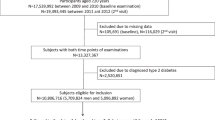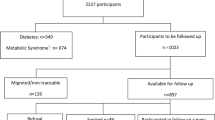Abstract
Background
Evaluating the process of changes in the Metabolic Syndrome (MetS) components over time is one of the ways to study of the MetS natural history. This study aimed to determine the trend of changes in the progression of MetS from its isolated components.
Methods
This longitudinal study was performed on four follow-up periods of the Tehran Lipid and Glucose Study (TLGS) between 1999 and 2015. The research population consisted of 3905 adults over the age of 18 years. MetS was diagnosed based on the Joint Interim Statement (JIS). The considered components were abdominal obesity, hypertension, hyperglycemia, and dyslipidemia.
Results
The highest incidence of MetS from its components was related to hypertension in the short term (3.6-year intervals). In the long run, however, the highest increase in the MetS incidence occurred due to abdominal obesity. Overall, the incidence of MetS increased due to obesity and dyslipidemia, but decreased due to the other factors. Nonetheless, the trend of MetS incidence from all components increased in total. The most common components were dyslipidemia with a decreasing trend and obesity with an increasing trend during the study.
Conclusion
The results indicated that obesity and hypertension components played a more important role in the further development of MetS compared to other components in the Iranian adult population. This necessitates careful and serious attention in preventive and control planning.


Similar content being viewed by others
Availability of data and material
The datasets used and/or analyzed during the current study are available from the corresponding author on reasonable request.
References
Zafar U, Khaliq S, Ahmad HU, Manzoor S, Lone KP. Metabolic syndrome: an update on diagnostic criteria, pathogenesis, and genetic links. Hormones (Athens, Greece). 2018;17(3):299–313.
Zambon S, Zanoni S, Romanato G, Corti MC, Noale M, Sartori L, et al. Metabolic syndrome and all-cause and cardiovascular mortality in an Italian elderly population: the Progetto Veneto Anziani (pro.V.a.) study. Diabetes Care. 2009;32(1):153–9.
Ford ES. Risks for all-cause mortality, cardiovascular disease, and diabetes associated with the metabolic syndrome: a summary of the evidence. Diabetes Care. 2005;28(7):1769–78.
Alberti KG, Zimmet P, Shaw J. The metabolic syndrome--a new worldwide definition. Lancet (London, England). 2005;366(9491):1059–62.
Carnethon M, Loria C, Hill J, Sidney S, Savage P, Liu K. Risk factors for the metabolic syndrome the coronary artery risk development in young adults (CARDIA) study, 1985–2001. Diabetes Care. 2004;27:2707–15.
Li R, Li W, Lun Z, Zhang H, Sun Z, Kanu JS, et al. Prevalence of metabolic syndrome in Mainland China: a meta-analysis of published studies. BMC Public Health. 2016;16:296.
Wu LT, Shen YF, Hu L, Zhang MY, Lai XY. Prevalence and associated factors of metabolic syndrome in adults: a population-based epidemiological survey in Jiangxi province. China BMC Public Health. 2020;20(1):133.
Kuzuya M, Ando F, Iguchi A, Shimokata H. Age-specific change of prevalence of metabolic syndrome: longitudinal observation of large Japanese cohort. Atherosclerosis. 2007;191(2):305–12.
Van Hemelrijck M, Ulmer H, Nagel G, Peter R, Fritz J, Myte R, et al. Longitudinal study of body mass index, dyslipidemia, hyperglycemia, and hypertension in 60,000 men and women in Sweden and Austria. PLoS One. 2018;13:e0197830.
Lee M-K, Han K, Kim MK, Koh ES, Kim ES, Nam GE, et al. Changes in metabolic syndrome and its components and the risk of type 2 diabetes: a nationwide cohort study. Sci Rep. 2020;10(1):2313.
Huh JH, Ahn SG, Kim YI, Go T, Sung KC, Choi JH, et al. Impact of longitudinal changes in metabolic syndrome status over 2 years on 10-year incident diabetes mellitus. Diabetes Metab J. 2019;43(4):530–8.
Ingelsson E, Pencina MJ, Tofler GH, Benjamin EJ, Lanier KJ, Jacques PF, et al. Multimarker approach to evaluate the incidence of the metabolic syndrome and longitudinal changes in metabolic risk factors. Circulation. 2007;116(9):984–92.
Jia X, Chen Q, Wu P, Liu M, Chen X, Xiao J, et al. Dynamic development of metabolic syndrome and its risk prediction in Chinese population: a longitudinal study using Markov model. Diabetol Metab Syndr. 2018;10:24.
Hwang L-C, Bai C-H, You S-L, Sun C-A, Chen C-J. Description and prediction of the development of metabolic syndrome: a longitudinal analysis using a Markov model approach. PLoS One. 2013;8(6):e67436.
Haring R, Rosvall M, Völker U, Völzke H, Kroemer H, Nauck M, et al. A network-based approach to visualize prevalence and progression of metabolic syndrome components. PLoS One. 2012;7(6):e39461.
Barcelo MA, Rodriguez-Poncelas A, Saez M, Coll-de-Tuero G. The dynamic behaviour of metabolic syndrome and its components in an eight-year population-based cohort from the Mediterranean. PLoS One. 2017;12(5):e0176665.
DeFronzo RA, Ferrannini E. Insulin resistance. A multifaceted syndrome responsible for NIDDM, obesity, hypertension, dyslipidemia, and atherosclerotic cardiovascular disease. Diabetes Care. 1991;14(3):173–94.
Azizi F, Zadeh-Vakili A, Takyar M. Review of Rationale, Design, and Initial Findings: Tehran Lipid and Glucose Study. Int J Endocrinol Metab. 2018;16(4 (Suppl)):e84777.
Azizi F. Tehran Lipid and Glucose Study: A National Legacy. Int J Endocrinol Metab. 2018;16(4 Suppl):e84774-e.
Azizi F. Tehran lipid and glucose study: a legacy for prospective community-based research. Archives of Iranian medicine. 2014;17(6):392–3.
Huque MH, Moreno-Betancur M, Quartagno M, Simpson JA, Carlin JB, Lee KJ. Multiple imputation methods for handling incomplete longitudinal and clustered data where the target analysis is a linear mixed effects model. Biometric J Biometrische Zeitschrift. 2020;62(2):444–66.
Huque MH, Carlin JB, Simpson JA, Lee KJ. A comparison of multiple imputation methods for missing data in longitudinal studies. BMC Med Res Methodol. 2018;18(1):168.
De Silva AP, Moreno-Betancur M, De Livera AM, Lee KJ, Simpson JA. Multiple imputation methods for handling missing values in a longitudinal categorical variable with restrictions on transitions over time: a simulation study. BMC Med Res Methodol. 2019;19(1):14.
De Silva AP, Moreno-Betancur M, De Livera AM, Lee KJ, Simpson JA. A comparison of multiple imputation methods for handling missing values in longitudinal data in the presence of a time-varying covariate with a non-linear association with time: a simulation study. BMC Med Res Methodol. 2017;17(1):114.
Patrician PA. Multiple imputation for missing data. Res nursing health. 2002;25(1):76–84.
Duffy ME. Handling missing data: a commonly encountered problem in quantitative research. Clinical nurse specialist CNS. 2006;20(6):273–6.
El-Masri MM, Fox-Wasylyshyn SM (2005) Missing data: an introductory conceptual overview for the novice researcher. The Canadian journal of nursing research = Revue canadienne de recherche en sciences infirmieres;37(4):156–71.
Alberti KGMM, Eckel Robert H, Grundy Scott M, Zimmet Paul Z, Cleeman James I, Donato Karen A, et al. Harmonizing the metabolic syndrome. Circulation. 2009;120(16):1640–5.
Hosseini-Esfahani F, Bahadoran Z, Moslehi N, Asghari G, Yuzbashian E, Hosseinpour-Niazi S, et al. Metabolic Syndrome: Findings from 20 Years of the Tehran Lipid and Glucose Study. Int J Endocrinol Metab. 2018;16(4 Suppl):e84771-e.
Azizi F, Khalili D, Aghajani H, Esteghamati A, Hosseinpanah F, Delavari A, et al. Appropriate waist circumference cut-off points among Iranian adults: the first report of the Iranian National Committee of obesity. Archives of Iranian medicine. 2010;13(3):243–4.
Rose GA, Blackburn H. Cardiovascular survey methods. Monograph series World Health Org. 1968;56:1–188.
Ainsworth BE, Jacobs DR Jr, Leon AS. Validity and reliability of self-reported physical activity status: the lipid research clinics questionnaire. Med Sci Sports Exerc. 1993;25(1):92–8.
Center AC (1997) ARIC Manuals of Operation: Cohort component procedures. (2)
Ma W-Y, Yang C-Y, Shih S-R, Hsieh H-J, Hung CS, Chiu F-C, Lin MS, Liu PH, Hua CH, Hsein YC, Chuang LM, Lin JW, Wei JN, Li HY Measurement of waist circumference: midabdominal or iliac crest? Diabetes Care 2013;36(6):1660–6, 1666.
Scuteri A, Morrell CH, Najjar SS, Muller D, Andres R, Ferrucci L, et al. Longitudinal paths to the metabolic syndrome: can the incidence of the metabolic syndrome be predicted? The Baltimore longitudinal study of aging. J Gerontol A Biol Sci Med Sci. 2009;64(5):590–8.
Sarebanhassanabadi M, Jalil Mirhosseini S, Mirzaei M, Namayandeh SM, Soltani MH, Pedarzadeh A, et al. The incidence of metabolic syndrome and the Most powerful components as predictors of metabolic syndrome in Central Iran: a 10-year follow-up in a cohort study. Iran Red Crescent Med J. 2017;19(7):e14934.
Janghorbani M, Amini M. Incidence of metabolic syndrome and its risk factors among type 2 diabetes clinic attenders in Isfahan. Iran Endokrynologia Polska. 2012;63(5):372–80.
Jiang B, Li B, Wang Y, Han B, Wang N, Li Q, et al. The nine-year changes of the incidence and characteristics of metabolic syndrome in China: longitudinal comparisons of the two cross-sectional surveys in a newly formed urban community. Cardiovasc Diabetol. 2016;15:84.
Hadaegh F, Hasheminia M, Lotfaliany M, Mohebi R, Azizi F, Tohidi M. Incidence of metabolic syndrome over 9 years follow-up; the importance of sex differences in the role of insulin resistance and other risk factors. PloS one. 2013;8(9):e76304-e.
Zabetian A, Hadaegh F, Sarbakhsh P, Azizi F. Weight change and incident metabolic syndrome in Iranian men and women; a 3 year follow-up study. BMC Public Health. 2009;9:138.
Santos AC, Severo M, Barros H. Incidence and risk factors for the metabolic syndrome in an urban south European population. Prev Med. 2010;50(3):99–105.
Balkau B, Vernay M, Mhamdi L, Novak M, Arondel D, Vol S, et al. The incidence and persistence of the NCEP (National Cholesterol Education Program) metabolic syndrome. The French D.E.S.I.R. study. Diabetes Metab. 2003;29(5):526–32.
Li Y, Yatsuya H, Iso H, Tamakoshi K, Toyoshima H. Incidence of metabolic syndrome according to combinations of lifestyle factors among middle-aged Japanese male workers. Prev Med. 2010;51(2):118–22.
Tang X, Liu Q. Prediction of the development of metabolic syndrome by the Markov model based on a longitudinal study in Dalian City. BMC Public Health. 2018;18(1):707.
Palaniappan L, Carnethon MR, Wang Y, Hanley AJG, Fortmann SP, Haffner SM, et al. Predictors of the incident metabolic syndrome in adults. Diabetes Care. 2004;27(3):788–93.
Chen X, Chen Q, Chen L, Zhang P, Xiao J, Wang S. Description and prediction of the development of metabolic syndrome in Dongying City: a longitudinal analysis using the Markov model. BMC Public Health. 2014;14:1033.
Klop B, Elte JWF, Cabezas MC. Dyslipidemia in obesity: mechanisms and potential targets. Nutrients. 2013;5(4):1218–40.
Acknowledgments
This article is the result of Pezhman Bagheri’s PhD thesis with registration code: SUMS.98/19936. We have to express our sincere thanks to all the personnel of the Shahid Beheshti University of Medical Sciences (SBMU) research institute for endocrine sciences for respectable cooperation in data collection phase that lead to the outcome of this project.
Funding
This study was financially supported by the Vice-Chancellor for Research and Technology of Shiraz University of Medical Sciences (SUMS), which is worthy of thanks and appreciation.
Author information
Authors and Affiliations
Contributions
P.B. developed the theory and performed the analysis, the literature search, assessed the literature, extracted data, wrote the manuscript with support from D.K. and A.R... A.R. with D.K. also encouraged and supervised the findings of this work, design and implementation of the research. F.A. in data establishment and the planning process of the main study has played a major role. M.S., EKM, and EB. verified the analytical methods and procedures.
Corresponding author
Ethics declarations
Conflicts of interest/competing interests
The authors declare that they have no competing interests.
Ethics approval
This study was based on the TLGS cohort study data, therefore, it was ethically subject to the ethical considerations considered in this project and was independently the result of a research project approved by the National Ethics Committee on Biomedical Research of Iran under code IR.SUMS.REC.1398.835.
Consent to participate
In TLGS project, people in admission time, declare their consent to participate as part of ethical considerations.
Consent for publication
Not applicable.
Code availability
Not applicable.
Additional information
Publisher’s note
Springer Nature remains neutral with regard to jurisdictional claims in published maps and institutional affiliations.
Rights and permissions
About this article
Cite this article
Khalili, D., Bagheri, P., Seif, M. et al. The dynamics of metabolic syndrome development from its isolated components among Iranian adults: findings from 17 years of the Tehran lipid and glucose study (TLGS). J Diabetes Metab Disord 20, 95–105 (2021). https://doi.org/10.1007/s40200-020-00717-8
Received:
Accepted:
Published:
Issue Date:
DOI: https://doi.org/10.1007/s40200-020-00717-8




